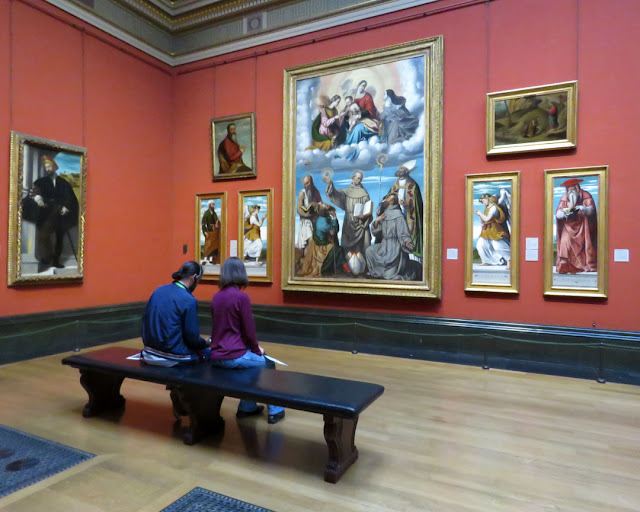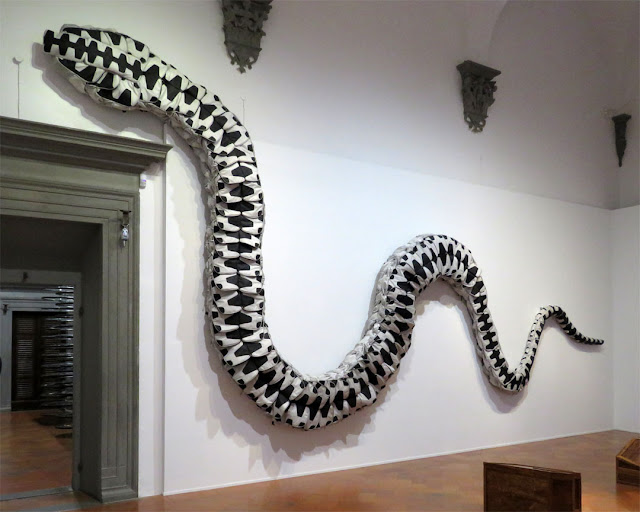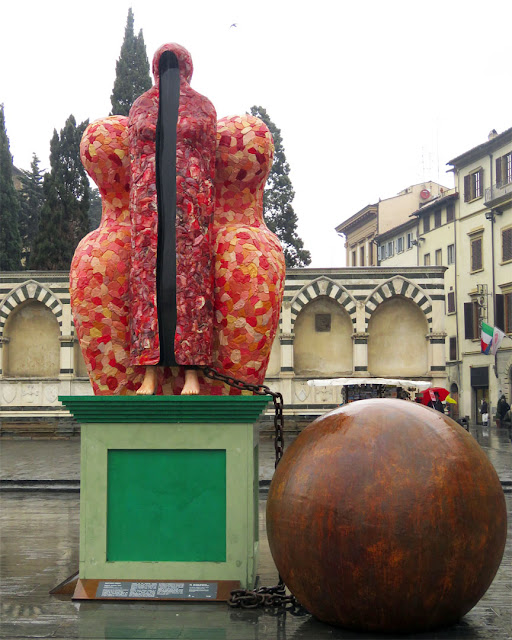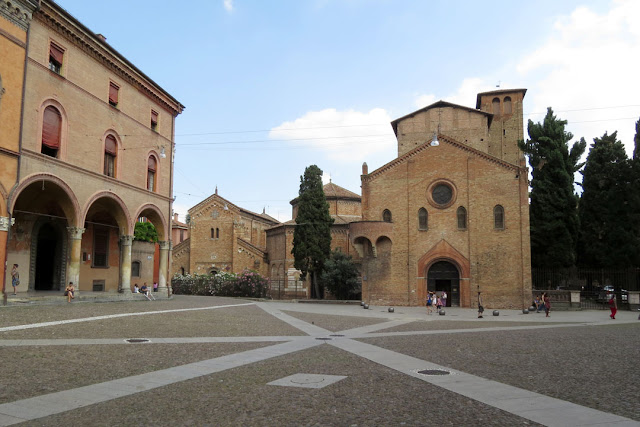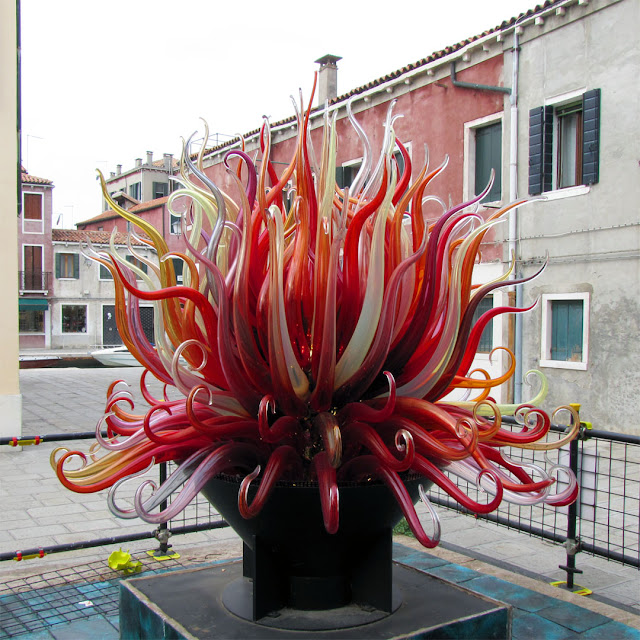Sunday, April 30, 2017
Lutheran Evangelical Church
Lutheran Evangelical church by Riccardo Mazzanti, 1901
Lungarno Torrigiani
Florence, January 2017
“Just a stone's throw from the picturesque Ponte Vecchio in the Oltrarno quarter (meaning ‘the other side of the Arno’) is the little Chiesa Luterana, built to serve the German-speaking Lutheran community of Florence. Established in 1901, the diminutive chapel was designed by architect Riccardo Mazzanti. It's a slender brick building iwth a rose window and white marble splashes of decoration on the exterior, while the simple interior is rather austere, in keeping with the traditional churches of northern Europe. Wedged between apartment buildings and fronting a little piazza, it's near the Pitti Palace but is a far cry from the opulence of that palazzo. The little church ministered to the predominantly Swiss and German protestant immigrants who wanted a church service in their native language. It has since been ‘Italianized’ but retains some services and events in the German language. The some church community hosts weekly concerts every Wednesday evening from April through October, utilizing the organ and international artists for spiritual music and fellowship.” (Lutheran Evangelical Church, Summer in Italy)
Saturday, April 29, 2017
The Catalan Folk Song
“La canción popular catalana” (The Catalan Folk Song) by Miguel Blay, 1907
Palau de la Música Catalana by Lluís Domènech i Montaner, 1908
Carrer de Sant Pere Més Alt
Barcelona, March 2017
“In 1905, Blay was approached by Modernist architect Lluis Domènech i Montaner to create a group of sculptures for the facade of El Palau de Musica Catalana, a concert hall in Barcelona. The building is known for its Art Nouveau style and is made up of a mix of glass, metalwork, sculpture, and ceramic mosaics. Miguel Blay created a group of sculptures titled “La canción popular catalana” (The Catalan Folk Song) for the facade of the building. The sculptures depict different characters of varying social classes: children, peasants, sailors, etc. In the center, there is a female figure that represents the Catalan song. Above her the patron saint of Barcelona, Sant Jordi, stands holding a sword, protecting her and the other sculptures. It is said to show that people of all classes can enjoy the traditional Catalan music.” (Miguel Blay, Wikipedia)
Friday, April 28, 2017
Palazzo Pubblico
Palazzo Pubblico and Torre del Mangia
Piazza del Campo
Siena, April 2017
“The Palazzo Pubblico (town hall) is a palace in Siena, Tuscany, central Italy. Construction began in 1297 and its original purpose was to house the republican government, consisting of the Podestà and Council of Nine. The outside of the structure is an example of Italian medieval architecture with Gothic influences. The lower story is stone; the upper crenelatted stories are made of brick. The facade of the palace is curved slightly inwards (concave) to reflect the outwards curve (convex) of the Piazza del Campo, Siena's central square of which the Palace is the focal point. The campanile or bell tower, Torre del Mangia, was built between 1325 and 1344 with its crown designed by the painter, Lippo Memmi. The tower was designed to be taller than the tower in neighboring rival Florence; at the time it was the tallest structure in Italy. It was fitted with a mechanical clock during the mid-14th century. Its design has been used as the basis for several other campaniles including the Dock Tower in Grimsby, England constructed in 1852 and the Joseph Chamberlain Memorial Clock Tower in the Edgbaston campus of the University of Birmingham (completed in 1908).” (Palazzo Pubblico, Wikipedia)
Thursday, April 27, 2017
Moretto da Brescia
“The Madonna and Child with Saints” by Moretto da Brescia, 1545
National Gallery
Trafalgar Square
London, September 2016
“The saints include Saint Jerome (with his lion) and Saint Joseph (with his flowering staff). The original destination of this altarpiece was probably a chapel or Franciscan church dedicated to Saint Bernardino, who is shown with his monogram of the name of Jesus (IHS) and three mitres at his feet. The mitres are inscribed with the three bishoprics of Urbino, Siena and Ferrara which the saint refused to accept. Also represented are Saint Francis (showing his stigmata), Saint Nicholas of Bari (holding three gold spheres), Saint Catherine of Alexandria (accepting a ring from Christ, in allusion to her vision of a ‘mystic marriage’), and Saint Clare holding the monstrance.” (The Madonna and Child with Saints, The National Gallery)
Wednesday, April 26, 2017
Snake Bag
“Snake Bag” by Ai Weiwei, 2008
“Ai Weiwei. Libero” exhibition
Palazzo Strozzi
Piazza degli Strozzi
Florence, January 2017
“The most compelling installation, however, deals with the Sichuan earthquake in 2008 in which thousands perished. Ai has funnelled his outrage into several composite sculptures in the years since embarking on his own investigation into the disaster, an enquiry that has blamed the guilty and contributed to his ongoing harassment by the authorities. In Snake Bag (2008), 360 identical backpacks stitched together into a serpentine line stretching across an entire wall recalls the 5,000 schoolchildren killed in the tragedy when the metal supporting new buildings buckled and collapsed.” (Up, up Ai Weiwei, The Florentine)
Tuesday, April 25, 2017
Le Théâtre Rond
Former “Le Théâtre Rond” (The Round Theatre)
Place Gabriel Kaspereit
Quartier Saint-Georges, 9th arrondissement
Paris, July 2014
Monday, April 24, 2017
Palazzo Salviati
Palazzo Salviati, Dorsoduro
Canal Grande (Grand Canal)
Venice, September 2013
“Palazzo Salviati is a palace on the Grand Canal in the Dorsoduro district (or sestieri) in Venice, northern Italy. It is situated between the Palazzo Barbaro Wolkoff and Palazzo Orio Semitecolo. The building was built as a shop and the furnace of the Salviati family between 1903 and 1906, designed by the architect Giacomo Dell'Olivo. The company was founded in 1859 by Antonio Salviati. In 1924 the building underwent a major renovation, which involved the addition of an extra floor and the placement of a large mosaic façade. Structurally the façade is relatively simple, with arched doors on the first and third floors and matching arched windows on the second floor. Attention is drawn to the mosaic figures that cover most of the façade, with a very large mosaic in the center of the building and smaller mosaics over the doors on the first floor and at the top of the third.” (Palazzo Salviati, Wikipedia)
Sunday, April 23, 2017
European Robin
European robin, 9/11 Memorial Garden
Grosvenor Square, Mayfair
London, September 2016
“Robins are one of the only UK birds to be heard singing in the garden on Christmas day. This is because they hold their territories all year round, warning off intruders with song. Males may hold the same territory throughout their lives, and will even attack a bundle of red feathers or their own reflection if they mistake it for another individual. Their melodious voices, along with their cheeky attitudes, have endeared robin red breasts to the British public, and in 1960 they were crowned the UK's national bird.” (Robin, BBC Nature)
Saturday, April 22, 2017
Chiesa del Sacro Cuore
Chiesa del Sacro Cuore (Church of the Sacred Heart) by Lando Bartoli, 1962
Via Capo di Mondo
Florence, January 2017
“Ludovico da Casoria, a Franciscan priest, founder of the Congregation of Frati Bigi, had the church built between 1874 and 1877, on the model of San Salvatore al Monte. The church is situated in Firenze (Campo di Marte). In 1941 it became a parish church and the building was completely restructured by the architect Lando Bartoli between 1956 and 1962. For the extremely modern bell tower the architect was assisted by Pier Luigi Nervi. There is a stained glass window of the Resurrection by Marcello Avelani, bronze doors and ceramic saints by Angelo Biancini, mosaic Stations of the Cross by Giovanni Haynal, a cruzifix by Umberto Bartoli, a 16th-century Madonna and Child, a Last Supper by Giovanni Stradano and the Apparition of the Sacred Heart by Antonio Ciseri (1880).” (Sacro Cuore, Wikipedia)
Friday, April 21, 2017
Doctor Robert Monument
Doctor Robert monument by Josep Llimona i Bruguera, 1910
Plaça de Tetuan
Barcelona, March 2017
“The square's central area contains the Doctor Robert monument by the sculptor Josep Llimona. Robert was a professor of internal pathology at the University of Barcelona. He was appointed mayor of Barcelona in 1899 and elected to the Spanish Parliament in 1901. The monument was built in Plaça de la Universitat between 1904 and 1910, commissioned by mayor Lluís Domènech i Montaner. The monument was dismantled in 1940 during the Franco dictatorship and moved to Plaça de Tetuan in 1985.” (Plaça de Tetuan, Wikipedia)
Thursday, April 20, 2017
Italian Clock
Italian Clock (with the Rome time) by Giuseppe Valadier, 1785
Basilica di San Pietro (St. Peter's Basilica)
Piazza San Pietro Saint Peter's Square
Città del Vaticano (Vatican City)
Rome, April 2013
See also: Oltremontano
Wednesday, April 19, 2017
The Goose Wing Entrance
The Goose Wing Entrance, Cross Bones graveyard
Union Street, The Borough, Southwark
London, September 2016
“In John Constable's vision, The Goose is the spirit of Cross Bones, protecting her outcast children. Local artist-woodworker Arthur de Mowbray drew on this vision, and the Invisible Gardener's idea for ‘a cloister’, to create this stunning entrance structure, which symbolises The Goose protectively spreading her wing over visitors as they enter the garden. It serves both as a shelter and as a rainwater harvester; rain runs down through timber gutters into the pond. Carved into the beams, you can read one of the poems from The Southwark Mysteries - ‘Here lay your hearts, your flowers...’ - which is recited at all the vigils, as well as John's dedication to those buried at Crossbones. Arthur also created the timber seats built into the drystone wall beds, and our garden tool shed, known as The Clink, complete with a carving of a gargoyle of the Bishop of Winchester spitting water onto a goose's back. All the wood used in Arthur's creations was sustainably sourced personally by him.” (History, Crossbones)
Tuesday, April 18, 2017
Tacca's Fountain
Fountain with sea monsters by Pietro Tacca, 1629
(With Bernardino Radi and Francesco Maria Bandini)
Piazza della Santissima Annunziata
Florence, January 2017
“Two bronze fountains originally destined for Livorno (c. 1629), still in a highly Mannerist style indebted to Flemish Mannerist goldsmith's work for their grotesque masks and shellwork textures, were set up instead in Piazza della SS. Annunziata, Florence.” (Pietro Tacca, Wikipedia)
Monday, April 17, 2017
Estadi Olímpic Lluís Companys
Estadi Olímpic Lluís Companys, renovated in 1985-89
(Built as Estadio de Montjuic by Pere Domènech i Roura, 1929)
Anella Olímpica (Olympic Ring)
Passeig Olímpic, Montjuïc
Barcelona, March 2017
“Estadi Olímpic Lluís Companys, formerly known as the Estadi Olímpic de Montjuïc and Estadio de Montjuic) is a stadium in Barcelona, Catalonia, Spain. Originally built in 1927 for the 1929 International Exposition in the city (and Barcelona's bid for the 1936 Summer Olympics, which were awarded to Berlin), it was renovated in 1989 to be the main stadium for the 1992 Summer Olympics. The stadium has a capacity of 54,000 (67,007 during the 1992 Olympics), and is located in the Anella Olímpica, in Montjuïc, a large hill to the southwest of the city which overlooks the harbor. In 2001 the stadium was renamed after the former president of the Generalitat de Catalunya Lluís Companys, who was executed at the nearby Montjuïc Castle in 1940 by the Franco regime.” (Wikipedia)
Sunday, April 16, 2017
Armani & Vuitton
Giorgio Armani and Louis Vuitton stores
Palazzo Taverna
Via Monte Napoleone
Milan, November 2016
“The Palazzo Taverna is a late Neoclassical mansion in Milan, Italy, designed by Ferdinando Albertolli in 1835. It is located at 2, Via Montenapoleone, in the Porta Nuova district of the city. The building is notable in that it is reminiscent of Milan's Royal Villa and of country houses in general as the main body of the building is set back to form a courtyard next to the street. The entrance consists of an Ionic colonnade supporting a parapet. The two lateral sections have giant pilasters surmounted by triangular tympani. Today the mansion houses a Louis Vuitton store.” (Palazzo Taverna, Wikipedia)
Saturday, April 15, 2017
Only Children Bench
“Only Children Bench” by Pablo Reinoso, 2016
Riverwalk, Westminster
London, September 2016
“Riverwalk is located by the river Thames, near the Tate Britain and next to Henry Moore sculpture Locking Piece, which has been on display in Riverside Walk Gardens, since 1968. In line with Stanton William’s architecture and especially in keeping with one of Henry Moore's most symbolic works, Pablo Reinoso has create two bench-sculptures in black steel. Only Children Bench, created to be used by the children as a playful area and We Watch You Too Bench, an other bench-sculpture which provides an area for quiet contemplation in the Riverwalk grounds, whose name is an amusing reference to the MI6 which is just opposite.” (Pablo Reinoso art at Riverwalk, Custot Gallery Dubai)
Friday, April 14, 2017
Maestà Tradita
“Maestà tradita” by Gaetano Pesce
Piazza Santa Maria Novella
Florence, January 2017
“Thought for the public area in connection with its historical, artistic and religious context, Pesce’s new sculpture will be displayed in Piazza Santa Maria Novella close to the extraordinary facade of the basilica designed by Leon Battista Alberti on a previous installation. His monumental sculpture represents a woman wrapped up in a long cloak: she is a sort of Mater Matuta (like the one at the Florence Archeological Museum), and also an archetype inspired by the Christian Maestà. Therefore, the sculpture is the contemporary echo of the very famous Madonna Rucellai – which was commissioned to Duccio di Boninsegna in 1285 by the Laudesi confraternity for their chapel in Santa Maria Novella church. At the end of the sixteenth century, it was moved to the Rucellai chapel of the Dominican church, while in the XX century, it arrived at the Uffizi Museum. The Maestà Tradita is seated on a throne that is on an high pedestal itself. However, her figure of queen and mother clearly shows signs of pain. Her cloak is also her body, her uncovered body and her nude skin. It is a grazed, scourged body and an uncovered skin exposed and marked by verbal and physical abuse and violence. A big and heavy rusted metal sphere is tied to the right foot of the woman, with a strong chain as a symbol of the slavery that thousands of women are still suffering in many countries of the world.” (Gaetano Pesce, Maestà Tradita, Museo Novecento)
Thursday, April 13, 2017
Wednesday, April 12, 2017
Santissima Annunziata del Vastato
Basilica della Santissima Annunziata del Vastato
Piazza della Nunziata
Genoa, April 2016
“The church was begun by the Franciscans in 1520 in a site previously occupied by the small church of Santa Maria del Prato, belonging to the Humiliati. Works were however halted in 1537, and in 1591 the Lomellini family continued the reconstruction, directed by Taddeo Carlone. In the early 17th century the rich Baroque decoration was executed, with Andrea Ansaldo in charge of completing the works, and in particular the dome. The current Neoclassicist façade dates to 1830-1840s, designed by Carlo Barabino. The church was damaged by Allied bombings during World War II.” (Basilica della Santissima Annunziata del Vastato, Wikipedia)
Tuesday, April 11, 2017
Green Wall
Green wall, Edgware Road tube station
Marylebone Road
London, September 2016
“The visually stunning green wall has taken just a month to install and, as well as having practical environmental benefits, is an attractive leafy addition to Marylebone Road. It features a total of 15 plant varieties crafted into a multi-coloured and patterned design. Studies across Europe and the USA have shown the potential of vegetation, including trees and plants, to trap PM10. The air quality benefits of this wall will be monitored by scientists from Imperial College London. The green wall is just one of a range of innovative and targeted measures being introduced by the Mayor, Boris Johnson, to deliver cleaner air in London at places where particulate matter (PM10) pollution is highest.” (Stunning green wall unveiled at Edgware Road Tube station, Transport for London)
Monday, April 10, 2017
Art Institute of Florence
Istituto d'arte di Firenze (Art Institute of Florence)
Piazzale di Porta Romana
Florence, January 2017
“The Art Institute of Florence opened in 1869 as a school of carving, was converted in 1880 to a trade school for the decorative arts, and finally became an industrial and artistic institute in 1919. Since 1924, the Institute has been located on the premises that housed the royal stables of the palace of Palazzo Pitti, very close to the Porta Romana, in the middle of a park that borders on the Boboli Gardens. The Royal Stables and its environs are located near the surviving walls of Florence. It has long been the center of controversy for being improperly used as an access point to the Boboli Gardens or as a parking lot for automobiles. It is from here that Robert and Sienna seek access to the Boboli Gardens in the novel Inferno. A project was recently approved for the improvement and redevelopment of this green space. Today, the Institute is called the Art School of the Porta Romana (Liceo Artistico di Porta Romana) and it houses the most interesting collection of plaster models in Italy, especially models of the art of the Florentine Renaissance. Over the years, 3000 plaster casts of important masterpieces of sculpture have been collected here dating from the fourteenth to the twentieth century. The most important models are those related to the works of Donatello and those from the collection of the Accademy Gallery.” (Liceo Artistico di Porta Romana, Florence Inferno)
Sunday, April 9, 2017
Sant Francesc de Sales
Church of Sant Francesc de Sales by Joan Martorell, 1885
Passeig de Sant Joan
Barcelona, March 2017
“One beautiful example of this is the Church of St. Francis de Sales on the Passeig de Sant Joan, one of the broad avenues leading up from the old city to the new. The church is considered the finest Neo-Gothic structure in the city, and the greatest example of the work of Joan Martorell i Montells, one of Gaudí’s teachers and an important influence on his pupil’s understanding of both surface treatment and interior space. Despite its Victorian uprightness, it anticipates in its decoration some of the wildness of Modernista decoration with which Gaudí and others would come to define late 19th and early 20th century Barcelona.” (Sant Francesc de Sales, Catholic Barcelona)
Saturday, April 8, 2017
Piazza Santo Stefano
Piazza Santo Stefano
Bologna, June 2015
“Piazza Santo Stefano also known as Piazza delle Sette Chiese (Seven churches square) is a piazza of Bologna, Italy. It is a pedestrianised triangular space near the beginning of Via Santo Stefano, both of which are named after the Basilica of Santo Stefano which is located on the piazza. Often used for cultural events, flea-markets and concerts, it has porticos along both long sides (North-East and South-West) with the Basilica occupying the short (South-East) side. To the left of the Basilica is a complex of buildings joined by the powerful medieval Isolani family. From the left side you can reach Strada Maggiore (formerly the Via Aemilia) via the Corte Isolani passage which was created in renovations to the Palazzo Isolani in 1999. On the right is Palazzo Bolognini Amorini Salina, notable for its frieze with terracotta heads, and the ‘Case Tacconi’, a good example of Bolognese merchant houses of the fifteenth century.” (Piazza Santo Stefano, Wikipedia)
Friday, April 7, 2017
Lovers on Horseback
“Lovers on Horseback” by Sophie Ryder, 2013
Grosvenor Square, Mayfair
London, September 2016
“Ryder graduated in 1984 in Combined Art at the Royal Academy of Arts, receiving a diploma in painting. She was encouraged to develop her studies in sculpting. Most of Sophie Ryder's sculptures are of mythical creatures and humans and animals. She uses animals to explore human emotions and showing that feelings can be read.” (Sophie Ryder, Wikipedia)
Thursday, April 6, 2017
Sant'Ambrogio
Tabernacle of Sant'Ambrogio by Giovanni della Robbia, 1525
Piazza Sant'Ambrogio (Borgo La Croce / via de' Macci)
Florence, January 2017
Wednesday, April 5, 2017
Hotel Porta Fira
Hotel Porta Fira by Toyo Ito, 2010
Plaça d'Europa, L'Hospitalet de Llobregat
Barcelona, March 2017
“The hotel tower was designed with an organic form and appears to change as one moves around it. Given the building’s geometrical complexity, the façade is divided into two skins. The inner skin is a sealed envelope based on a light curtain-wall solution with aluminium and glass panels designed to fully meet all acoustic, thermal and sealing requirements. The exterior façade acts as a second skin that provides texture and accommodates the tower’s variable geometry. The skin is made of independent aluminium tubes whose ends are attached to ball-and-socket joints that allow for the desired torsion.” (Porta Fira Towers, ArchDaily)
(Already posted on Instagram)
Tuesday, April 4, 2017
Monday, April 3, 2017
London Bridge Staircase
London Bridge Staircase by Bere Architects, 2016
London Bridge / River Walkway
London, September 2016
“The new staircase is cantilevered over the River Thames, connecting London Bridge and the River Walkway on the north bank of the Thames. It is clearly identifiable and its curved landings offer panoramic views across the river and spectacular views of Tower Bridge. The new route is spacious and light, and benefits from natural surveillance, ensuring people now feel comfortable and safe when walking between the Bridge and the Riverside. The site was identified by bere:architects as suitable for a new staircase, in spite of its many constraints. It is hemmed in by London Bridge and the Riverside Walkway beneath, and sits directly above London Underground's Northern Line. Furthermore, no vertical load could be carried by London Bridge at this location, and no loads could be put into the river wall beneath, nor directly into the river bed. So a series of 13.5 metre piles were drilled extremely carefully into neighbouring land, to avoid penetrating the Northern Line underground tunnel directly below. The staircase was prefabricated off-site by the marvellous Littlehampton Welding, and lowered into place over the side of London Bridge over a series of weekend road closures, with Mackley Construction acting as a superbly capable main contractor. Capita performed the role of structural engineer, Keller took care of the specialist piling design and installation, and Quentin Newark of Atelier Works designed the exquisite information panels.” (London Bridge Staircase, bere:architects)
Sunday, April 2, 2017
Saturday, April 1, 2017
Hôtel Gaillard
Hôtel Gaillard
A detail of the seen from rue de Thann
Place du Général-Catroux
Quartier de la Plaine-de-Monceaux, 17th arrondissement
Paris, July 2011
“The building remained empty, until the mansion was sold to the Banque de France in 1919 to become one of its branches. The rehabilitation works were made by architect Alphonse Defrasse between 1919 and 1921, and by interior decorator Jansen. It was listed historic monument by a bylaw of April 12, 1999. At the end of 2014, the Banque de France will open a Cité de l'économie et de la monnaie in the building. It will be a place dedicated to the discovery of economic concepts. The winning team that will carry the project is constituted by Ateliers Lion (Yves Lion) for the architecture, François Confino for the museography, and Eric Pallot as specialist of historic monuments.” (Hôtel Gaillard, Wikipedia)
Subscribe to:
Posts (Atom)




